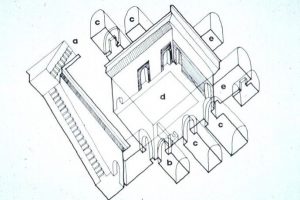
Yaodong Pit Houses
- admin
- 09-24-2021
Yaodong Pit Houses
Loess Plateau, China
Facts:
- -Yaodong means “cave building”, Yaodong are a series of buildings (caves) dug horizontally or vertically into the earth
- -Dwellings are able to withstand temperature variations during hot summers and cold winters due to the insulation provided by the earth and clay as well as the shape of the structures.
- -Great examples of sustainable design.
- -3 types of Yaodong: Cliffside, Sunken (aka Pit) and Hoop Yaodong
- -Currently estimated more than 40 million people reside in these cave houses in Northern China
- -Most famous Yaodong are in Yan’an. Mao Zedong headquarted in this area 1935-1948.

Epoch:
2nd Millenium BC to present day

Location:
The Loess Plateau in Northern China, situated in 5 provinces: Gansu,Shanxi, Shaanxi, Henan,and Ningxia

Commentary:
Dating back to China’s Bronze age and the Xia Dynasty, Yaodong have provided shelter and comfortable living spaces in rural areas of the Loess Plateau and continue to be used today.
The 3 types of Yaodong are named for their location and style of construction.
Cliffside Yaodong are built into the cliff’s edge with the front of the cave providing light and ventilation with a rectanguolar floor and the top arched. The walls are made of wood pilings against a soil wall with beams and columns supporting the structure. These are the most common type of Yaodong and can be further classified as 1,2 or 3-hole types.
The Sunken or Pit Yaodong are dug around a square pit or excavation site, which serves as a courtyard, with the caves dug further into the walls underground. The 2 types of entrances, slope-entrance and flat-entrance, both are excavated pits with design differences in the way the caves entrances are constructed. These structures are called the well-courtyards or the Well-Yaodong.
The Hoop Yaodong is considered the most valuable type.These are built in areas where there is no ability for excavations, the slopes of the Plateau are very small or the height of cliffs are too low so these are free standing structures.These are built outdoors with an arched or vaulted structure similar to the underground Yaodongs. The arch shaped buildings with high windows allow for sunlight to shine in the caves for light and warmth. The design also reflects “Round Sky, Square Earth” in classic Chinese philosophy. These usually have 3 or 5 caves, built with a reuseable wood mold for the center courtyard, and the structures are built with brick walls to make the arches and 2 meters of soil mud outside the structure for insulation.
Takeaways:
Sorry folks, but sustainable living has been around for a long, long time.
Having stood the test of time, these structures are diverse, creative and sustainable. Green construction from the distant past that has sustained farmers, rural communities and revitalization to ease lack of housing continues to develop and evolve with young people appreciating the lower cost of building and maintaining these residences.
Other Readings:
-
- ”Chinese Earth-Sheltered Dwellings: Indigenous Lessons for Modern Urban Design” Gideon Golany, University of Hawaii Press 1992
- “Yaodong: China’s Pit Houses”, The Amusing Planet ,01/2018
- “Farmer’s Caves (Yaodong)” www. TravelChinaGuide.com
Source:
Thanks to Dr. Beth Sommers
ArchitologyTM is a registered trademark



Leave a Reply